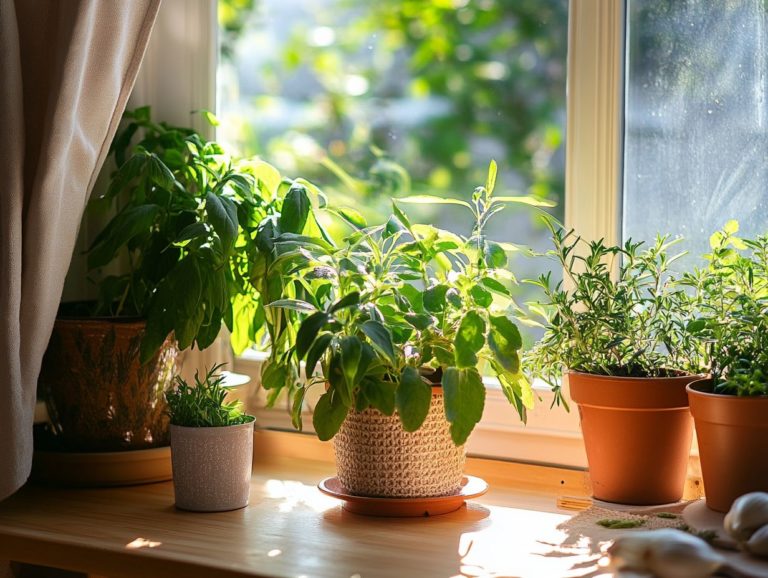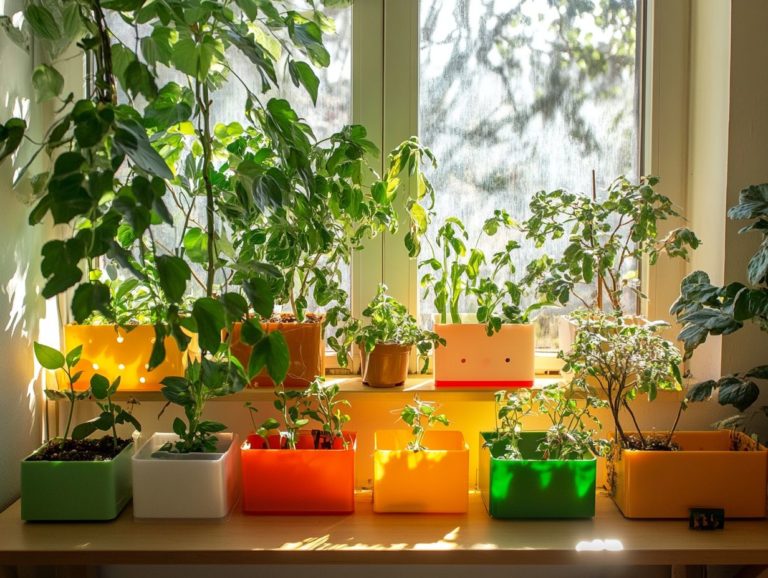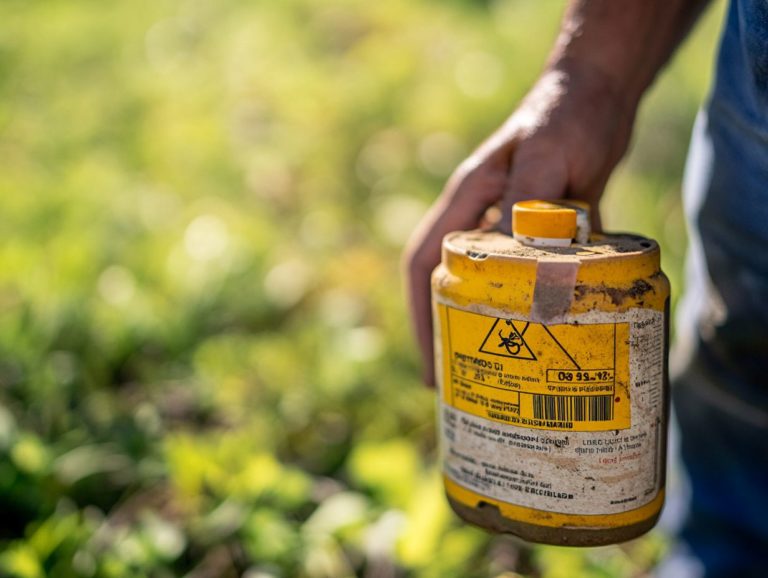Recognizing Signs of Root Rot in Plants
Root rot, a serious plant disease, poses a significant threat that can quietly devastate your cherished plants before you even become aware of it.
By understanding what root rot is, its causes, and the signs to look for, such as yellowing and wilting leaves, you can effectively safeguard your green companions. This article delves into the common culprits behind root rot, how to identify its symptoms, and effective strategies for both prevention and treatment.
You’ll find steps to rescue your plants from this lurking menace and learn how to treat root rot effectively. Immerse yourself in this guide to discover how to cultivate a thriving garden!
Contents
Key Takeaways:
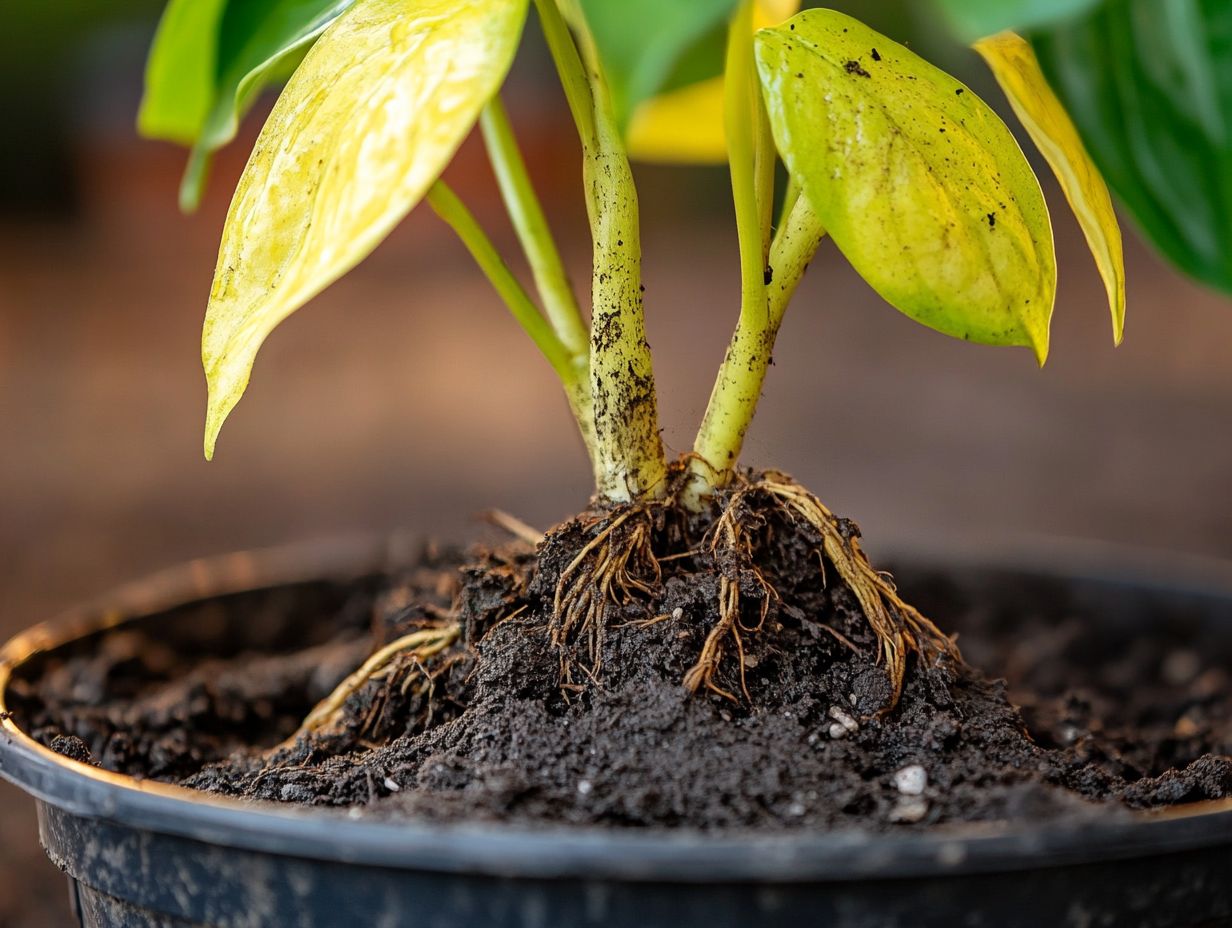
- Root rot is a fungal disease that affects plant roots, leading to decay and ultimately, death of the plant.
- Overwatering, poor soil drainage, and fungal infections are common causes of root rot in plants.
- Yellowing and wilting leaves, stunted growth, and root discoloration are signs of root rot. Proper preventive measures and timely treatment can help save plants from this disease.
Understanding Root Rot
Root rot can sneak up on you, but knowing its signs helps you act fast! Grasping the nuances of root rot is crucial for any dedicated plant enthusiast, whether you re nurturing indoor plants or tending to a flourishing garden.
Root rot typically arises when healthy roots become compromised, often due to overwatered conditions that lead to inadequate soil drainage. This affliction can wreak havoc on both houseplants and garden specimens, manifesting in symptoms such as yellowing leaves and wilting leaves. To learn more about this issue, check out what are the signs of root rot in indoor plants. These symptoms ultimately impact the growth and vitality of your cherished plants.
What is Root Rot?
Root rot is a significant plant disease you should know about. It is marked by the decay of healthy roots, primarily instigated by tiny organisms in the soil that can harm plants like pythium fungus and fusarium fungus.
These harmful organisms thrive in excessively moist conditions, where they invade the root system, impairing the plant’s capacity to absorb water and nutrients effectively. As these fungi multiply, you’ll notice the healthy roots beginning to rot, leading to a range of distress signals from the plant, including mushy roots. Initially, you might see wilting leaves, yellowing foliage, or stunted growth, all of which indicate the presence of plant dehydration and root rot.
In more advanced stages, the root systems can become mushy and discolored, often accompanied by a foul odor rising from the soil, indicating severe decay due to root rot. Knowing how these infections develop and manifest is vital for your plant care and prevention efforts to prevent root rot.
Causes of Root Rot
The causes of root rot are complex, primarily arising from overwatering and insufficient soil drainage, which can lead to fungal infections. These conditions create a damp environment, ideal for the proliferation of harmful fungi.
Common Culprits
Common culprits of root rot include notorious soil pathogens like pythium and fusarium fungi, which flourish in damp conditions and can swiftly undermine your plants’ health. These organisms are particularly cunning, as they not only disrupt the nutrient and water absorption capabilities of your plants but can also lead to wilting leaves and plant death if not addressed promptly.
Pythium, often linked to overly saturated soils, can affect a variety of species, including tomatoes and cucumbers, while fusarium generally zeroes in on specific hosts like bananas and other tropical plants, making prevention vital. To safeguard against these destructive fungi, focus on improving soil drainage, steering clear of overwatering, and implementing crop rotation as part of your plant care routine.
Being aware that conditions like high humidity and compacted soil foster fungal growth will be essential for maintaining healthy roots and robust plants, key to preventing root rot.
Signs and Symptoms of Root Rot

Recognizing root rot signs is vital for timely action. If you see yellow leaves and wilting foliage, your plant’s roots may be in trouble.
Addressing these issues early can be crucial for restoring your plants’ vitality and preventing further damage.
Visual Clues
Visual clues of root rot often include yellowing leaves, wilting foliage, and a decline in your plant’s vigor, indicating a need for immediate care. These signs act as early warnings that something is wrong with root health and may require treatment options like repotting.
Symptoms can vary based on the plant species. For example, one plant may exhibit drooping and limp stems, while another might show browning leaf edges or stunted growth, possibly with unusual mold at the base, signaling decay.
Timely observation of these visual cues is essential for gardeners and plant lovers who want to prevent root rot. Early action can be the difference between saving a struggling plant or letting the disease take hold.
Recognizing these clues offers valuable insights into soil conditions and necessary adjustments for healthier roots.
Effects on Plant Health
The impact of root rot on plant health can be devastating. It can lead to compromised root systems and stunted growth, undermining overall vitality.
When pathogens like Pythium or Phytophthora invade, your plant s ability to absorb vital nutrients, such as nitrogen, phosphorus, and potassium, greatly decreases. This nutrient deficiency hinders new growth and makes your plants more vulnerable to stressors like drought or disease, worsening root rot effects.
Over time, this lack of nutrient uptake triggers a chain reaction: reduced photosynthesis from inadequate leaf development, weakened stems, and a drop in flower or fruit production, all signs of root rot. The repercussions extend beyond your garden, affecting the entire ecosystem; unhealthy plants can’t support beneficial insects and wildlife that rely on them, emphasizing the need for effective plant care.
Preventing and Treating Root Rot
Preventing and treating root rot is crucial for your plants’ health. It involves understanding soil drainage and moisture. By taking effective measures like ensuring good drainage, selecting the right potting mix, and using gardening gloves you can significantly reduce the risk of plant disease.
These steps not only protect your green companions but also enhance your gardening experience, allowing you to cultivate a thriving oasis while combating root rot.
Preventive Measures
Preventive measures are essential for avoiding root rot. They typically involve ensuring adequate drainage, using the right potting mix, and maintaining proper drainage holes in your pots to prevent overwatering.
To truly enhance your plants’ health, consider selecting a potting mix tailored for the specific type of plant you re nurturing. This can improve moisture retention and prevent root rot. Establishing a watering routine that matches your plant’s unique needs rather than using a one-size-fits-all approach will help you avoid waterlogged conditions that often lead to root rot.
Regularly check your pots for drainage issues, such as blockages or compacted soil. This is crucial for preventing root rot and ensuring healthy roots. For indoor plants, using pots that promote good airflow or incorporating moisture meters can provide valuable insights into soil moisture content, ensuring both indoor and garden enthusiasts are well-equipped for successful plant care.
Treatment Options
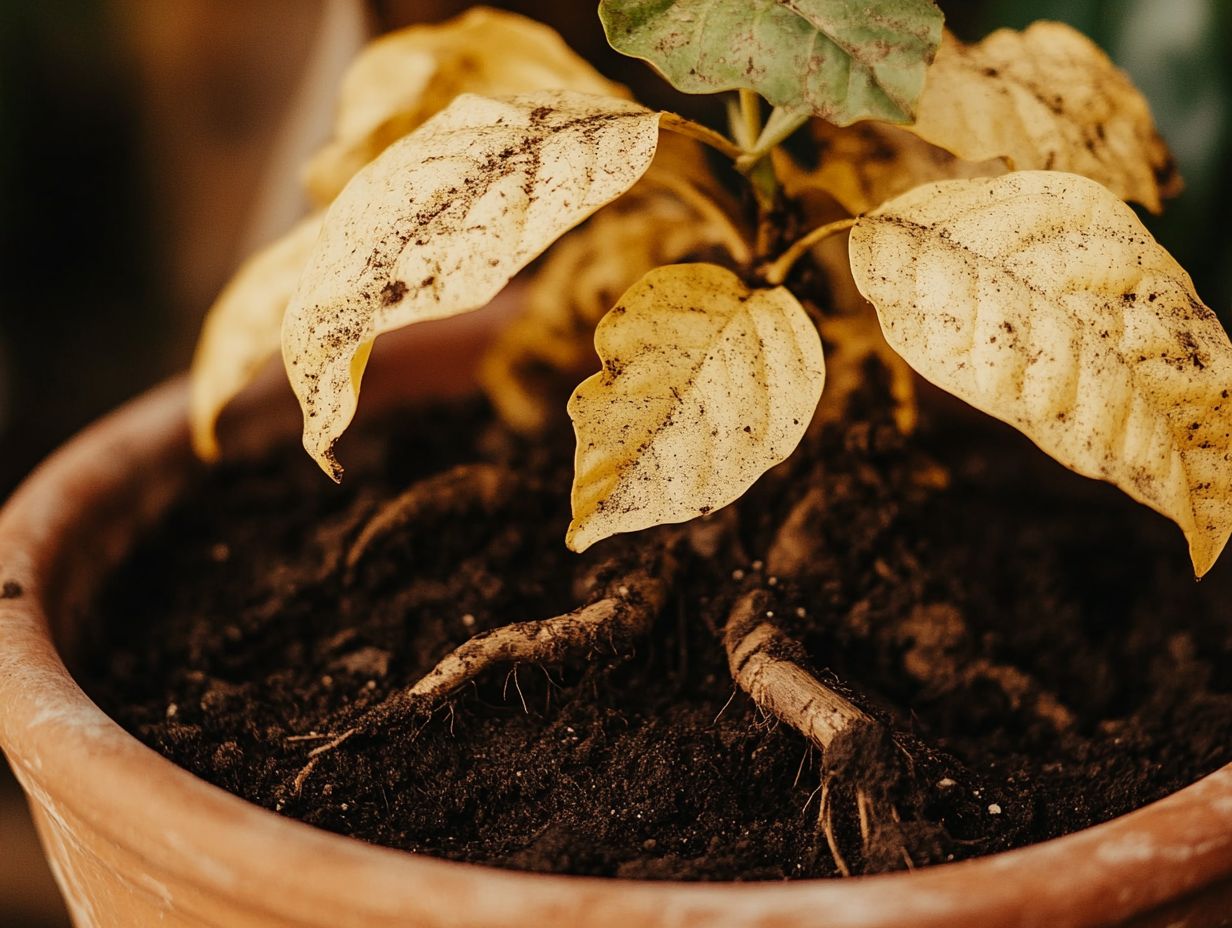
If you face root rot, you have several effective strategies. Consider repotting plants, using special plant treatments, or pruning shears to remove affected roots.
Also, incorporate compost to improve soil health and support healthy roots.
Each method has its advantages and can be tailored to the severity of the issue. For example, when repotting plants, gently lift the plant from its pot. Trim away any decayed roots and replace the old soil with fresh, well-draining material.
This creates a favorable environment for growth and effectively treats root rot.
Using special treatments can combat the pathogens responsible for root rot. Follow instructions meticulously to avoid harming beneficial microbes. Pruning shears are valuable tools, as they alleviate stress on the plant by removing infected roots.
Monitor your plant’s progress after treatment. Consistent observation allows you to make quick adjustments if symptoms persist or worsen.
Integrating a balanced compost can boost soil health significantly, paving the way for recovery and making your plant resilient against root rot.
How to Save Plants from Root Rot
To protect your plants from root rot, act promptly and decisively to prevent further damage. Consider repotting your plants for fresh soil, and use pruning shears to remove any affected areas.
Act now to rejuvenate those healthy roots and watch your plants thrive again!
Steps to Take
Start by assessing the extent of the damage and symptoms of root rot. This initial evaluation is vital. It empowers you to make informed decisions on your next steps for effective treatment.
Once you ve gauged the situation, reach for clean, sharp pruning shears to remove rotten roots. A precise cut minimizes harm to healthy roots and helps prevent infections.
When it’s time to repot, choose a container with drainage holes and opt for high-quality, well-aerated potting mix. This is essential for your plant’s recovery.
After repotting, keep a close eye on your plant for signs of new growth or stress. This vigilance allows you to assess health and intervene promptly if needed.
Tools like moisture meters can help maintain the right watering schedule, crucial for a successful recovery.
Frequently Asked Questions
What is root rot in plants?
Root rot is a fungal disease that affects the roots of plants, causing decay and death. It is one of the most common and destructive plant diseases. If left untreated, it can kill the entire plant.
What are the signs of root rot in plants?
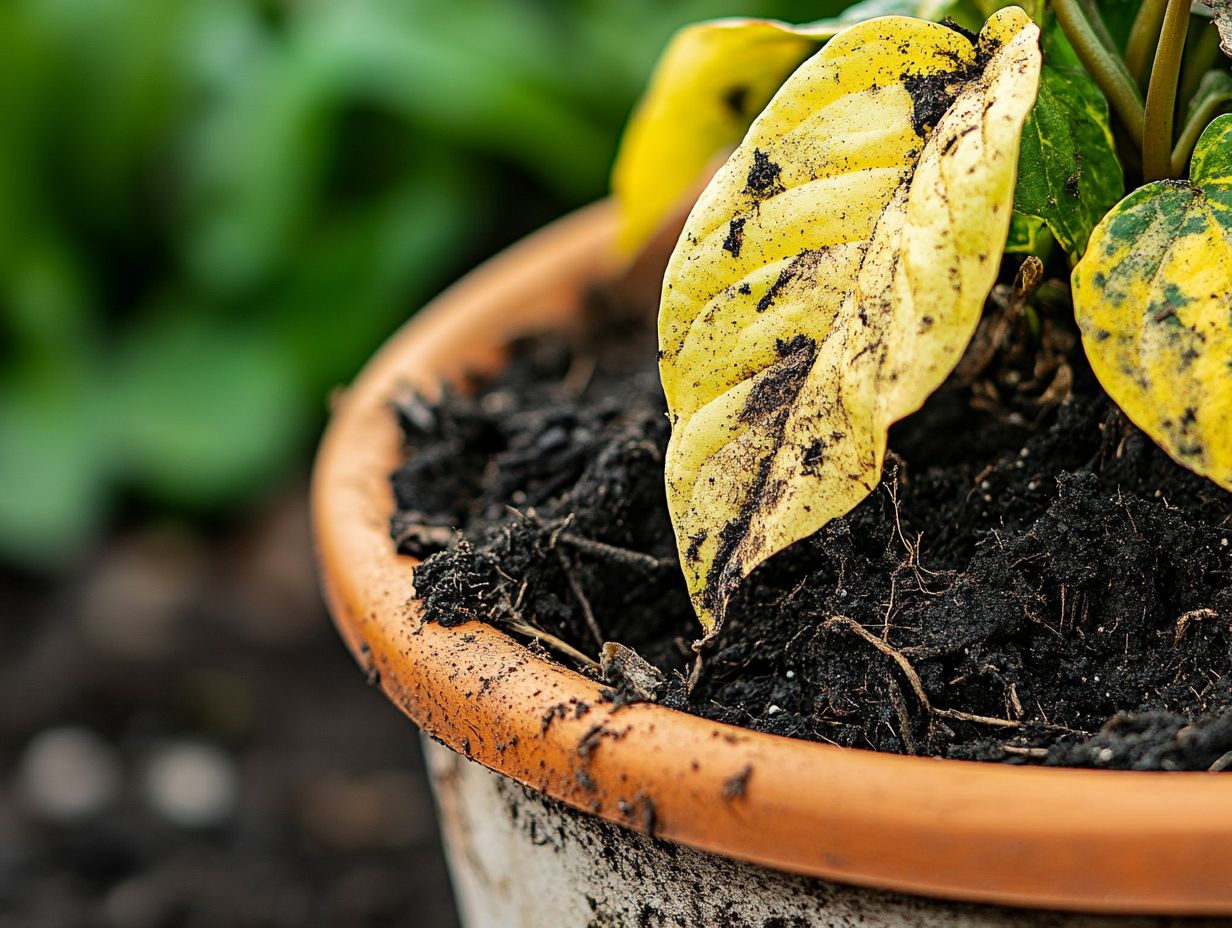
Common signs include wilting or yellowing leaves, stunted growth, and root discoloration. Plants with root rot may also emit a foul odor from the soil.
How does root rot affect a plant?
Root rot damages the root system, responsible for absorbing water and nutrients. This leads to weakness and improper growth, eventually resulting in death.
Which plants are most susceptible to root rot?
Plants grown in wet or poorly drained soil are most susceptible. This includes those with shallow root systems, like succulents, and those that are overwatered or watered too frequently.
Can root rot be treated?
Yes, root rot can be treated if caught early. The first step is to remove affected roots and replant in fresh, well-draining soil. Special treatments can also help control the disease’s spread.
How can I prevent root rot in my plants?
To prevent root rot, use well-draining soil and avoid overwatering your plants. Allow the soil to dry out between waterings and steer clear of areas with poor drainage.
Regularly check your plants for signs of root rot, which is when roots decay due to too much water. If you catch it early, you can treat it successfully!

